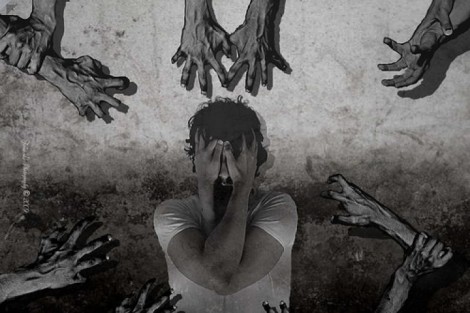Anxiety is pretty common in the human population. Research has shown that 1 in 4 people will experience an anxiety disorder in their lifetime. Anxiety can be separated from fear by the distinction that fear evolved as a response to a real or perceived immediate threat while anxiety is the expectation of a future threat. Imagine our ancestors, when confronted with a dangerous animal. The fear response kicks in and adrenaline starts flowing, allowing our ancestor more energy to get to safety, where the fear response would end.
An anxiety disorder is present when this response is triggered out of context. When a person suffers from anxiety, they can feel nervous, powerless, or a sense of impending doom. Their heart rate and breathing can increase and they can start sweating, trembling, and feeling weak. But there is no threat to get away from, and nothing to return them to equilibrium.
Experiencing anxiety attacks are not pleasant. Sometimes they can be situational, and the sufferer will try to avoid these situations that cause anxiety, but that’s not always possible. Drawing on Cognitive Behavioral Therapy (CBT) and Dialectical Behavioral Therapy (DBT), it is possible to improve your life if you suffer from an anxiety disorder.
Mindfulness
Mindfulness is the cornerstone of DBT. If your anxiety has a component of judgment to it, Mindfulness may be the way to go. The state of mindfulness is described as a “non-judgmental, present-centered awareness”. While you are practicing mindfulness, it forces you to be in the present moment, which can help focus an anxious mind.
An exercise you can try to bring your mind to the present is to simply sit in your room, and then name one thing you see. Keep breathing. Then, name one thing you hear. Then, name one thing you are touching. Then, name one thing you can smell. Then, one thing you can taste. Continue doing this until you have named 5 things you experience with each sense, or until the anxiety has lessened.
Making yourself aware of your senses in the present allows your body to focus on what is really going on instead of the maladaptive danger signals.
Cognitive Behavioral Therapy
CBT is used to approach your thinking patterns. Through CBT you can challenge those thoughts that are negative and are bringing you to that place where you are identifying a situation as more dangerous than it really is. There are three steps to challenging your negative thoughts.
*Identify the negative thoughts
This might sound hard to do, but it becomes easier with practice. When you begin to feel anxious, ask yourself what thoughts are running through your head at the moment. Try to write these thoughts down for future reference.
*Challenge the negative thoughts
This step can be helpful if you have someone who can help you remain in objective reality. You can use strategies such as pros and cons lists of avoiding your fears, or checking out your negative thoughts to see if there is evidence for them, or if they are based in reality. Once you’ve isolated and identified the thoughts behind your anxiety you can move on to the third step.
*Replace the negative thoughts
Try to come to a more balanced place. If you’re afraid that people are talking about you behind your back, and the anxiety makes it hard to be in crowds of strangers, using steps 1 and 2 you may have identified that you think people dislike you. If you try to challenge that thought, you could check for evidence and find that strangers are rarely noticing you. At this point, you can try to remind yourself when you’re afraid of being judged, that strangers aren’t really thinking of you at all.
All of these techniques take practice to really become helpful, but they are immensely valuable once you’ve mastered them. Anxiety does not have to decrease the quality of your life.
via Learning Mind









